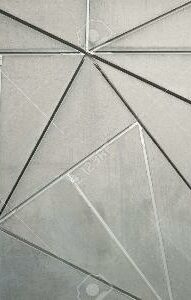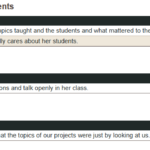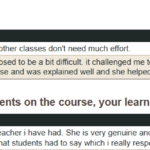research questions (RQ)
Although I had suspected that implementing a fully multimodal approach to First Year Composition would support students in becoming effective writers in contemporary spaces, I had to narrow my dissertation project using a set of thorough research questions. Once I performed the research, I could conclude if my particular approach was a viable curriculum to support FYC students.
RQ1
curriculum
How do students, in a Design-Focused Approach to First Year Composition, demonstrate achievement of multimodal learning outcomes?
RQ2
methods
How does the Design-Focused Approach used to develop DesigningFYC.com, perform rhetorical flexibility and rhetorical agency?
RQ3
pedagogy
How do students, in a Design-Focused Approach to First Year Composition, qualify the effects of design-thinking on their writing process and artifacts?
H
hypothesis
I take the position that the exploration of modal affordances MUST BE foundational to the First-Year writing course as students are expected to employ multiliterate skills that allow them to participate in larger conservations. I hypothesize that modeling the similarities among the processes (constructing, designing, writing, and making of a thing) evident in the arts and humanities will show students the value of writing by inherent problem-solving-whether it be in the rhetorical aspects of design or the content of the project.

“After reading the experts, reading some more stuff and then reading it all again, I recognized the importance of thinking through how to use words, how to use images and how to use them together to create effective relevant artifacts. so, my next job became how to get students to think about it too.”
SUBHEADING
multimodal pedagogy
Thinking about writing, in light of 21st century skills, inevitably leads to scholarly conversations about multimodal pedagogy. The turn to aligning literacy (multiliteracies) with the changing landscape of media and communication must be examined as a way to solve a problem implementing multimodal pedagogy to its potential. “Dialogic, multimodal learning creates situated, specific discourse opportunities for student-scholars to enter into academic conversations and affect change, using their own rhetorical voices,” asserts Jeanne L. Bohannon in her 2015 article “Not a Stitch Out of Place: Assessing Student’s Attitudes Towards Multimodal Composing.” In the interests of preparing students to function outside the university setting, compositionists have taken up a number of positions with regard to how multimodality should look in the classroom and most often those processes employ technology (Dobrin, 2011; Leveranz 2016; Wysocki et.al., 2004). What students should be able to do is explicitly addressed in the most recent iteration of the WPA Outcomes Statement for FYC (2014): “adapt composing processes for a variety of technologies and modalities.” However, multimodality is much more inclusive than just digitality (Shipka, 2011). As explicated in Khadka and Lee’s collection (2019) many instructors have attempted to implement such practices without much success. Instructors, both new and experienced, have been hesitant as a consequence of inadequate training, lack of resources and equipment, and disciplinary suitedness (Dunn, 2001; Khadka and Lee, 2019; Takayoshi and Self, 2007). Thus, the seminal and oft cited pedagogy of the New London Group (1996), stating the current need to acknowledge, teach and learn through multiliteracies, has been a slow implementation for scholars. On the other hand, these same scholars have continued their examination of social semiotics, modal affordances, and digitality. Currently, FYC is still struggling to see multimodality used as a framework, instead of arbitrary assignments. Synthesizing the work of the NLG with a focus on design, a number of composition scholars have been able to frame composing through a process that exceeds alphanumeric text (Ball and Arola, 2018; Marback, 2009; Palmeri 2012; Purdy, 2014). They claim when writers write, they are designing, especially in the current culture. The problem-solving process inherent in design thinking, is a way to bridge classroom praxis with value outside the academy (Leveranz, 2016; Orr et.al., 2006; Palmeri, 2012; Purdy, 2014; Shipka, 2011). Despite the many ways that the writing and designing processes align, it is important to note that some scholars have probed at the limitations that design-thinking can effect (Karjaluoto, 2014; Potter, 2007). Ball and Arola echo the benefits in pedagogical implications, put forth by the NLG, and assert that designing allows writer/designers to be “makers of [their] social futures.” In a 2019 chapter for Exquisite Corpse: Studio Art-Based Writing in the Academy titled,”The Artistry of Composition: Design Thinking in Writing Studies,” Vittorio Rubino concurs, “…through a design-oriented, multiliterate pedagogy, instructors can restore student agency through the act of making.”
visual theory & design
Design-thinking and its rhetorical emphasis becomes much clearer through scholarship that examines visual theory through its applications in writing in the academy. The foremost scholarly conversation centers on the affordances of an image in comparison to a text, or a combination of the two (Mitchell, 1994; Stephens, 1998; Vivian ,2007). The rhetorical quality of the writing process demands that students think of all available means and subsequently is not exclusive to linguistic practices (Dondis, 1973; Dunn, 2011). Writing for rhetorical purposes calls upon composing processes that are inherently multimodal (New London Group, 1999), so a critical examination of the ways compositionists can reframe such, with considerations beyond merely linguistic features, is important and necessary. As Kress and Van Leeuwen (2006) assert, each medium has limitations of meaning, not everything can be realized by language (p.19). Furthermore, in Gombrich’s The Image and the Eye (1960), he acknowledges that there is a power to images in capturing a moment or a feeling that words cannot (p.175). Kress and Van Leeuwen explain, “language is policed by the academy to be homogenized;” whereas people, on their own, combine and change and make [their]selves understood (p.5). In other words, academic composing has become a practice centered on standards and expectations that are restrictive (and consequently without personal purpose) for students to communicate themselves and their knowledge. Vittorio Rubino affirms, “students as not only writers, but as composers, are capable of analyzing, synthesizing, interpreting, evaluating, and creating not only formal, Standard English alphabetic texts, but also visual means of communication” (p.145). The operations that process how images are perceived and constructed in the mind, is an important topic taken up by Rudolf Arnheim (1969), who declares that perception should not be separated from thinking: “…educators and administrators cannot justify giving the arts an important position in the curriculum unless they understand that the arts are the most powerful means of strengthening the perceptual component without which productive thinking is impossible in any field of endeavor” (p.3). Here, composing in the academy becomes an exercise that draws on the magnitude of looking (what students see, just as importantly as what they want audiences to see in their work). The visual lens used for writing/designing deemphasizes a reliance on textual language. Drawing on scholarship that looks at the arbitrary nature of words will help to reify the representational value of visual form as evidenced in Gestalt theory and the Bauhaus (Arnheim, 1969; Dondis, 1973; Lupton, 2000).
bringing stuff together
Although it is not explicitly stated in the review of literature for multimodal pedagogy and visual theory, the story that emerges is one about the inextricable links between the different types of symbols the human eye sees. To inform writing instruction and make the work practical and relevant, instructors must think about the constraints of alphanumeric language, which is merely one system of symbols. Furthermore, instructors should think about challenging students to write outside of academic genres and instead for real world audiences, which would certainly demand the use of a multimodal approach. Synthesizing the scholarship of Kress, Van Leeuwen, Gombrich and Arnheim, creates a realistic picture of the considerations students should make as they sit down to compose a meaningful artifact. A multimodal approach to writing creates layers of meaning through the interplay between the intentions of the student writer/designer and the reception of their audience. Each of the rhetorical decisions that a student makes for their artifact has a potential consequence; however, some consequences may be unpredictable and create unique and unforeseen meaning (Marback, 2009). Various meanings are generated within the socio-cultural context where the artifact exists in addition to the prior knowledge and experience that the audience brings to it. Establishing meaningful ways to write is not only productive for students to understand the value of their education, but also validates the place of the composition sequence in the General Education Program. This is constructed through a delicate balance of situating the writer at the center of their work but energizing them through a “…limitless set of design possibilities” as Richard Marback asserts in “Embracing Wicked Problems: The Turn to Design in Composition Studies.”
In this dissertation project, I advocate the use of a Design-Focused Approach to First-Year Composition as a valuable and meaningful rhetorical practice. To use an example, the preparation of instructional materials is perceived as a design process, so it is logical to qualify the act of composing student artifacts in much the same way. Instructors combine elements and make deliberate choices about how to sequence assignments, how to explain what the assignment is and what the assignment is meant to do for students and their audience. Instructors build and mix activities, tools, and methods to create something unique that will meet a particular pedagogical end. But are they not making the kinds of moves that they seek from their own students? How might those students set a goal and strategize ways of materializing that goal from a set of possibilities? Design-thinking encourages students to compose in non-linear ways with non-linear tools. Jody Shipka affirms the importance of implementing a multimodal framework to the teaching of writing, because methods, materials and technologies can become prescriptive. She explains that traditional approaches encourage “one-sided views of production,” and students should instead be supported to “contextualize, frame and situate” based upon their values and goals.”
The DFA to FYC that I have implemented will not only showcase how students had s variety of modes and genres to develop their project artifacts, but how this particular approach offered students the tools, symbols, and methods to do the work.
student feedback
In each of their courses near the end of the semester, students are emailed with a link to Wayne State University’s Student Evaluation of Teaching system (SET). Per the Testing, Evaluation and Research Services page of the website, www.wayne.edu:
Student Evaluation of Teaching (SET) is a process through which students provide feedback on their course-related experiences, including the quality of teaching, course content, and classroom environment. This feedback can be used to improve the quality of instruction and academic programs and can help instructors identify areas where they can improve their teaching methods…The feedback collected through SET can be used to assess the effectiveness of individual instructors, to identify areas where improvements can be made, and to inform decisions about curriculum development and course offerings.
Below, I have included excerpts from the qualitative SET reports compiled for both sections of ENG 1020 that I instructed during the Fall of 2022.
SET 1
set 2
assessing the outcomes of the course according to the students
In the 1st SET, a student states,
“She was always enthusiastic about the topics taught and the students and what mattered to them.”
Although brief, it is important to confirm that this student felt seen and heard in the class. Furthermore, the student acknowledged that I encouraged them to pursue the topics and issues they wanted. This was perceived as my “enthusiasm” for and in the coursework, but I view this as my success in supporting student agency in their projects.
In the 2nd SET excerpt, the student writes,
“…it challenged me to be a better writ[er] and think more about my audience when writing, the projects made sense…”
With regard to the work for the class, a student recognized and valued the emphasis placed on the rhetorical situation. This is a testament to the theoretical underpinnings used during the curriculum development. Moreover, this student’s comment tells me that they connect effective writing with rhetorical awareness.

